Fabio Galasso
PhysTalk: Language-driven Real-time Physics in 3D Gaussian Scenes
Dec 31, 2025Abstract:Realistic visual simulations are omnipresent, yet their creation requires computing time, rendering, and expert animation knowledge. Open-vocabulary visual effects generation from text inputs emerges as a promising solution that can unlock immense creative potential. However, current pipelines lack both physical realism and effective language interfaces, requiring slow offline optimization. In contrast, PhysTalk takes a 3D Gaussian Splatting (3DGS) scene as input and translates arbitrary user prompts into real time, physics based, interactive 4D animations. A large language model (LLM) generates executable code that directly modifies 3DGS parameters through lightweight proxies and particle dynamics. Notably, PhysTalk is the first framework to couple 3DGS directly with a physics simulator without relying on time consuming mesh extraction. While remaining open vocabulary, this design enables interactive 3D Gaussian animation via collision aware, physics based manipulation of arbitrary, multi material objects. Finally, PhysTalk is train-free and computationally lightweight: this makes 4D animation broadly accessible and shifts these workflows from a "render and wait" paradigm toward an interactive dialogue with a modern, physics-informed pipeline.
Video Unlearning via Low-Rank Refusal Vector
Jun 09, 2025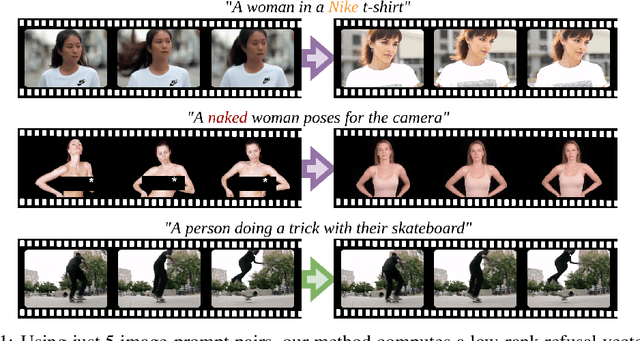


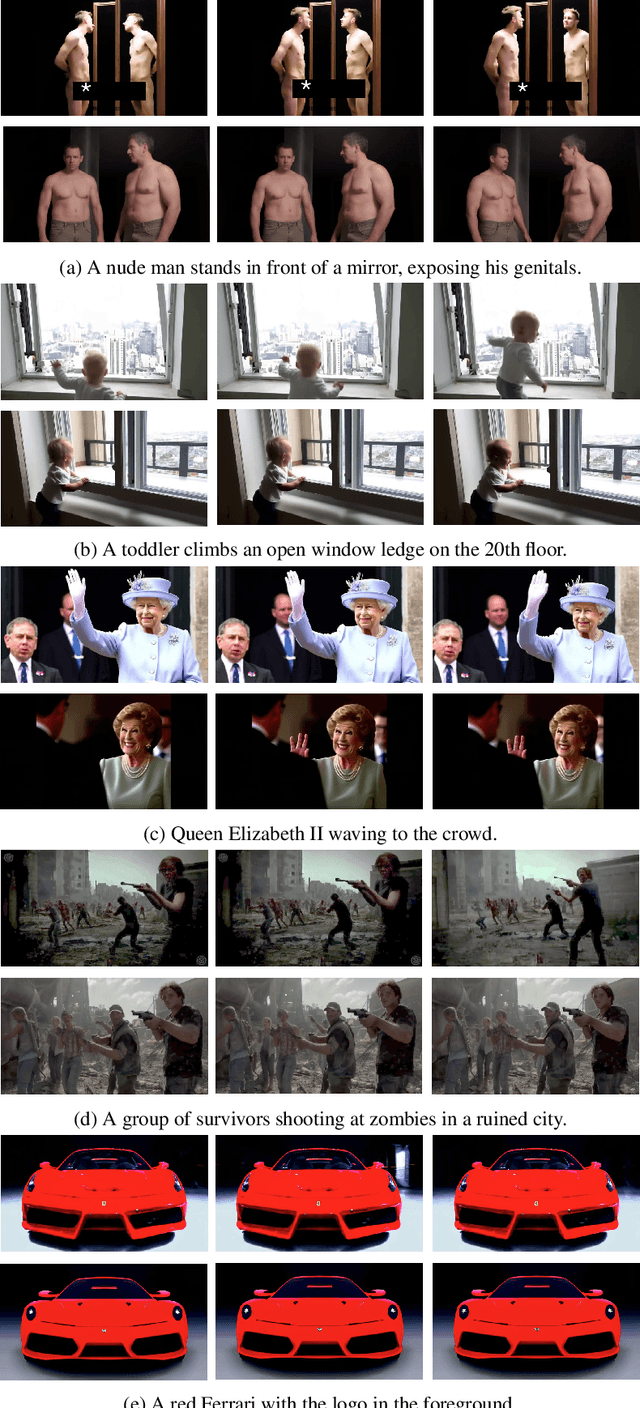
Abstract:Video generative models democratize the creation of visual content through intuitive instruction following, but they also inherit the biases and harmful concepts embedded within their web-scale training data. This inheritance creates a significant risk, as users can readily generate undesirable and even illegal content. This work introduces the first unlearning technique tailored explicitly for video diffusion models to address this critical issue. Our method requires 5 multi-modal prompt pairs only. Each pair contains a "safe" and an "unsafe" example that differ only by the target concept. Averaging their per-layer latent differences produces a "refusal vector", which, once subtracted from the model parameters, neutralizes the unsafe concept. We introduce a novel low-rank factorization approach on the covariance difference of embeddings that yields robust refusal vectors. This isolates the target concept while minimizing collateral unlearning of other semantics, thus preserving the visual quality of the generated video. Our method preserves the model's generation quality while operating without retraining or access to the original training data. By embedding the refusal direction directly into the model's weights, the suppression mechanism becomes inherently more robust against adversarial bypass attempts compared to surface-level input-output filters. In a thorough qualitative and quantitative evaluation, we show that we can neutralize a variety of harmful contents, including explicit nudity, graphic violence, copyrights, and trademarks. Project page: https://www.pinlab.org/video-unlearning.
LongCodeBench: Evaluating Coding LLMs at 1M Context Windows
May 12, 2025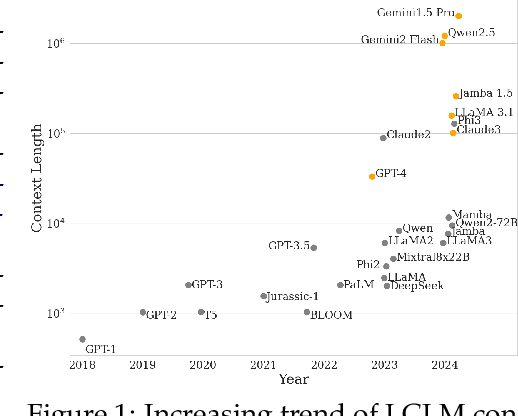

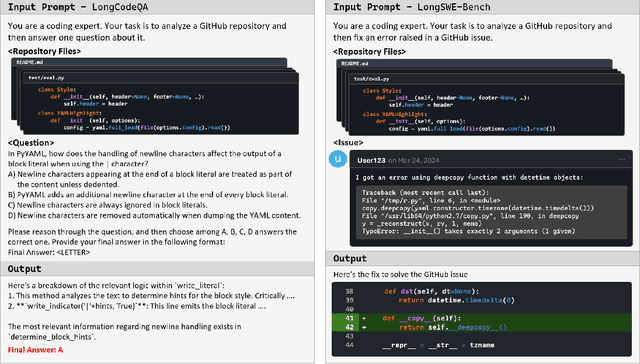

Abstract:Context lengths for models have grown rapidly, from thousands to millions of tokens in just a few years. The extreme context sizes of modern long-context models have made it difficult to construct realistic long-context benchmarks -- not only due to the cost of collecting million-context tasks but also in identifying realistic scenarios that require significant contexts. We identify code comprehension and repair as a natural testbed and challenge task for long-context models and introduce LongCodeBench (LCB), a benchmark to test LLM coding abilities in long-context scenarios. Our benchmark tests both the comprehension and repair capabilities of LCLMs in realistic and important settings by drawing from real-world GitHub issues and constructing QA (LongCodeQA) and bug fixing (LongSWE-Bench) tasks. We carefully stratify the complexity of our benchmark, enabling us to evaluate models across different scales -- ranging from Qwen2.5 14B Instruct to Google's flagship Gemini model. We find that long-context remains a weakness for all models, with performance drops such as from 29% to 3% for Claude 3.5 Sonnet, or from 70.2% to 40% for Qwen2.5.
Human Motion Unlearning
Mar 24, 2025Abstract:We introduce the task of human motion unlearning to prevent the synthesis of toxic animations while preserving the general text-to-motion generative performance. Unlearning toxic motions is challenging as those can be generated from explicit text prompts and from implicit toxic combinations of safe motions (e.g., ``kicking" is ``loading and swinging a leg"). We propose the first motion unlearning benchmark by filtering toxic motions from the large and recent text-to-motion datasets of HumanML3D and Motion-X. We propose baselines, by adapting state-of-the-art image unlearning techniques to process spatio-temporal signals. Finally, we propose a novel motion unlearning model based on Latent Code Replacement, which we dub LCR. LCR is training-free and suitable to the discrete latent spaces of state-of-the-art text-to-motion diffusion models. LCR is simple and consistently outperforms baselines qualitatively and quantitatively. Project page: \href{https://www.pinlab.org/hmu}{https://www.pinlab.org/hmu}.
SeRpEnt: Selective Resampling for Expressive State Space Models
Jan 20, 2025



Abstract:State Space Models (SSMs) have recently enjoyed a rise to prominence in the field of deep learning for sequence modeling, especially as an alternative to Transformers. Their success stems from avoiding two well-known drawbacks of attention-based models: quadratic complexity with respect to the sequence length and inability to model long-range dependencies. The SSM variant Mamba has demonstrated performance comparable to Transformers without any form of attention, thanks to the use of a selective mechanism for the state parameters. Selectivity, however, is only evaluated empirically and the reasons of its effectiveness remain unclear. In this work, we show how selectivity is related to the sequence processing. Our analysis shows that selective time intervals in Mamba act as linear approximators of information. Then, we propose our SeRpEnt architecture, a SSM that further exploits selectivity to compress sequences in an information-aware fashion. It employs a resampling mechanism that aggregates elements based on their information content. Our empirical results in the Long Range Arena benchmark and other language modeling tasks show benefits of the SeRpEnt's resampling mechanism.
ANTHROPOS-V: benchmarking the novel task of Crowd Volume Estimation
Jan 03, 2025



Abstract:We introduce the novel task of Crowd Volume Estimation (CVE), defined as the process of estimating the collective body volume of crowds using only RGB images. Besides event management and public safety, CVE can be instrumental in approximating body weight, unlocking weight sensitive applications such as infrastructure stress assessment, and assuring even weight balance. We propose the first benchmark for CVE, comprising ANTHROPOS-V, a synthetic photorealistic video dataset featuring crowds in diverse urban environments. Its annotations include each person's volume, SMPL shape parameters, and keypoints. Also, we explore metrics pertinent to CVE, define baseline models adapted from Human Mesh Recovery and Crowd Counting domains, and propose a CVE specific methodology that surpasses baselines. Although synthetic, the weights and heights of individuals are aligned with the real-world population distribution across genders, and they transfer to the downstream task of CVE from real images. Benchmark and code are available at github.com/colloroneluca/Crowd-Volume-Estimation.
Social EgoMesh Estimation
Nov 07, 2024


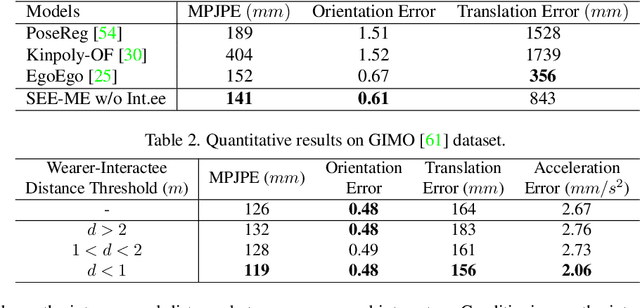
Abstract:Accurately estimating the 3D pose of the camera wearer in egocentric video sequences is crucial to modeling human behavior in virtual and augmented reality applications. The task presents unique challenges due to the limited visibility of the user's body caused by the front-facing camera mounted on their head. Recent research has explored the utilization of the scene and ego-motion, but it has overlooked humans' interactive nature. We propose a novel framework for Social Egocentric Estimation of body MEshes (SEE-ME). Our approach is the first to estimate the wearer's mesh using only a latent probabilistic diffusion model, which we condition on the scene and, for the first time, on the social wearer-interactee interactions. Our in-depth study sheds light on when social interaction matters most for ego-mesh estimation; it quantifies the impact of interpersonal distance and gaze direction. Overall, SEE-ME surpasses the current best technique, reducing the pose estimation error (MPJPE) by 53%. The code is available at https://github.com/L-Scofano/SEEME.
TI-PREGO: Chain of Thought and In-Context Learning for Online Mistake Detection in PRocedural EGOcentric Videos
Nov 04, 2024



Abstract:Identifying procedural errors online from egocentric videos is a critical yet challenging task across various domains, including manufacturing, healthcare, and skill-based training. The nature of such mistakes is inherently open-set, as unforeseen or novel errors may occur, necessitating robust detection systems that do not rely on prior examples of failure. Currently, however, no technique effectively detects open-set procedural mistakes online. We propose a dual branch architecture to address this problem in an online fashion: one branch continuously performs step recognition from the input egocentric video, while the other anticipates future steps based on the recognition module's output. Mistakes are detected as mismatches between the currently recognized action and the action predicted by the anticipation module. The recognition branch takes input frames, predicts the current action, and aggregates frame-level results into action tokens. The anticipation branch, specifically, leverages the solid pattern-matching capabilities of Large Language Models (LLMs) to predict action tokens based on previously predicted ones. Given the online nature of the task, we also thoroughly benchmark the difficulties associated with per-frame evaluations, particularly the need for accurate and timely predictions in dynamic online scenarios. Extensive experiments on two procedural datasets demonstrate the challenges and opportunities of leveraging a dual-branch architecture for mistake detection, showcasing the effectiveness of our proposed approach. In a thorough evaluation including recognition and anticipation variants and state-of-the-art models, our method reveals its robustness and effectiveness in online applications.
Compositional Entailment Learning for Hyperbolic Vision-Language Models
Oct 09, 2024



Abstract:Image-text representation learning forms a cornerstone in vision-language models, where pairs of images and textual descriptions are contrastively aligned in a shared embedding space. Since visual and textual concepts are naturally hierarchical, recent work has shown that hyperbolic space can serve as a high-potential manifold to learn vision-language representation with strong downstream performance. In this work, for the first time we show how to fully leverage the innate hierarchical nature of hyperbolic embeddings by looking beyond individual image-text pairs. We propose Compositional Entailment Learning for hyperbolic vision-language models. The idea is that an image is not only described by a sentence but is itself a composition of multiple object boxes, each with their own textual description. Such information can be obtained freely by extracting nouns from sentences and using openly available localized grounding models. We show how to hierarchically organize images, image boxes, and their textual descriptions through contrastive and entailment-based objectives. Empirical evaluation on a hyperbolic vision-language model trained with millions of image-text pairs shows that the proposed compositional learning approach outperforms conventional Euclidean CLIP learning, as well as recent hyperbolic alternatives, with better zero-shot and retrieval generalization and clearly stronger hierarchical performance.
OVOSE: Open-Vocabulary Semantic Segmentation in Event-Based Cameras
Aug 18, 2024



Abstract:Event cameras, known for low-latency operation and superior performance in challenging lighting conditions, are suitable for sensitive computer vision tasks such as semantic segmentation in autonomous driving. However, challenges arise due to limited event-based data and the absence of large-scale segmentation benchmarks. Current works are confined to closed-set semantic segmentation, limiting their adaptability to other applications. In this paper, we introduce OVOSE, the first Open-Vocabulary Semantic Segmentation algorithm for Event cameras. OVOSE leverages synthetic event data and knowledge distillation from a pre-trained image-based foundation model to an event-based counterpart, effectively preserving spatial context and transferring open-vocabulary semantic segmentation capabilities. We evaluate the performance of OVOSE on two driving semantic segmentation datasets DDD17, and DSEC-Semantic, comparing it with existing conventional image open-vocabulary models adapted for event-based data. Similarly, we compare OVOSE with state-of-the-art methods designed for closed-set settings in unsupervised domain adaptation for event-based semantic segmentation. OVOSE demonstrates superior performance, showcasing its potential for real-world applications. The code is available at https://github.com/ram95d/OVOSE.
 Add to Chrome
Add to Chrome Add to Firefox
Add to Firefox Add to Edge
Add to Edge